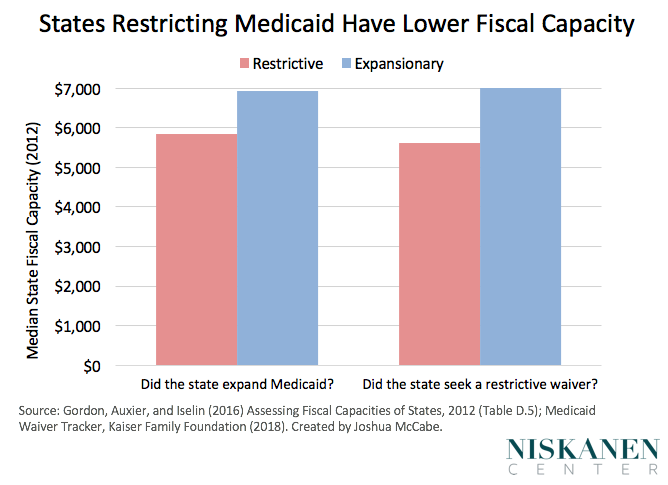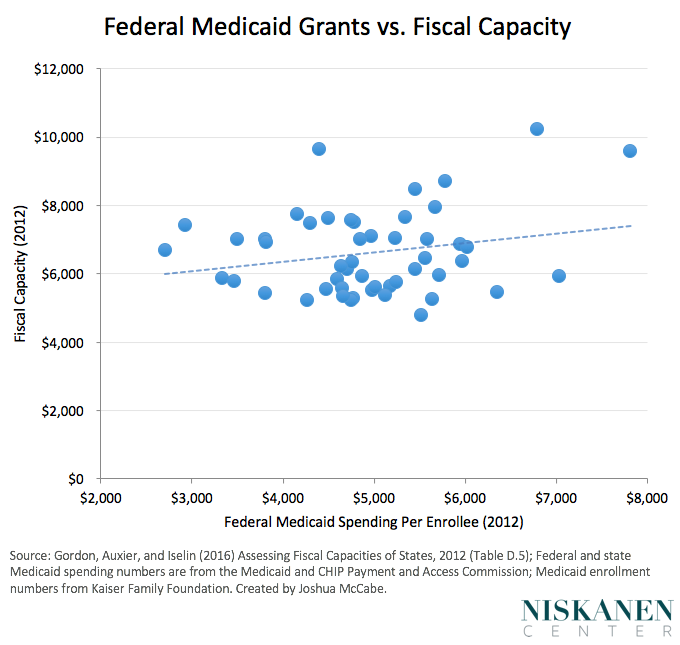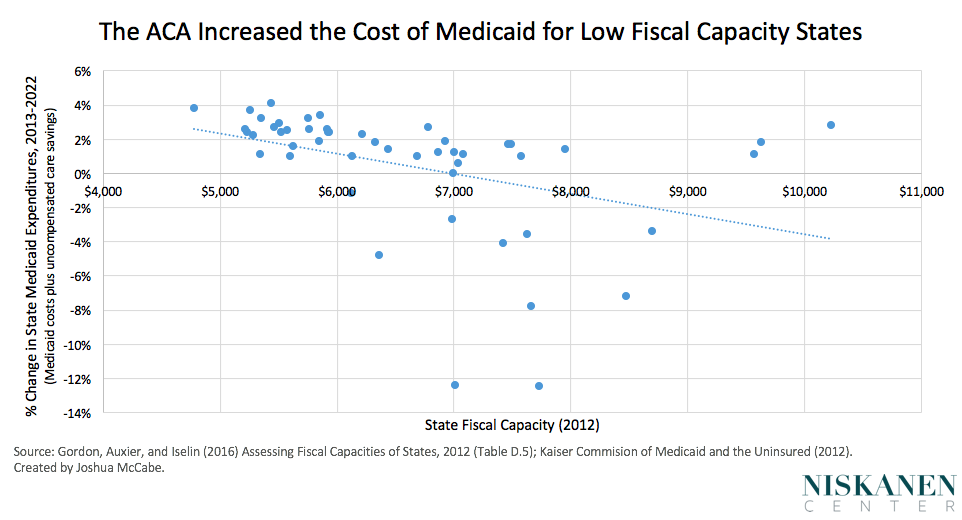The Government Accountability Office recently released a report looking at Medicaid’s effects on access to medical care in expansion and non-expansion states. They found that low-income adults in expansion states were less likely to report having unmet medical needs than those in non-expansion states. Like the Oregon experiment study finding Medicaid expansion reduced financial strain on beneficiaries, expansion advocates interpreted this study as clear evidence of the benefits of expanding Medicaid as widely as possible. Because of this, these same advocates are often at a loss to explain why 17 states have chosen not expand to Medicaid or why 21 states have applied for section 1115 Medicaid waivers to enact work requirements, eligibility restrictions, or benefit restrictions.
One common explanation is what could be called the “mean Republican” theory of Medicaid. The only conceivable reason why states might not expand Medicaid or might restrict access in light of its obvious benefits is because callous Republican policymakers in these states hate Obama, poor people, or both. Does this theory fit the evidence? After all, many of the most restrictive states are deep red southern states with histories of limiting social programs for the poor.
Yet looking non-expansion states through the lens of partisan control misses a crucial confounding factor: Non-expansion states are also deeply poor. Mississippi’s per capita GDP, for example, is less than half that of Massachusetts, while its poverty rate is double. This is important because Medicaid is a state-administered and partially state-funded program for the poor. Poor states like Mississippi are thus being asked to provide coverage to more people with fewer resources. In their zeal to tout the benefits of expansion, advocates have largely ignored the fiscal costs. The source of the problem becomes clear when we compare the fiscal capacity of states that have expanded Medicaid, and those that have either not pursued expansion or have applied for waivers to restrict the expansion’s scope.
Fiscal capacity refers to the total amount of taxable resources available to governments to raise revenue. A cursory examination reveals policymakers pursuing restrictive policies, whether through restrictive waivers or by refusing the Medicaid expansion altogether, are more likely to be found in poorer states with correspondingly lower fiscal capacity.

Critics sometimes contend that Medicaid expansion is worthwhile regardless of the cost. This argument ignores the opportunity costs states face with increasing Medicaid spending, which has more than doubled as a share of state budgets since 1990. Many of these states are already under immense fiscal pressures because they are expected to dedicate what meager resources they have to K-12 education, higher education, and basic social assistance. Budget pressures are compounded by the growth in state Medicaid spending, leading to crowd-out of these and other priorities. None of this is for lack of effort. The notion that red states have lower taxes burdens than blue states is largely a myth. State and local revenue as a percentage of personal income, a standard measure of fiscal effort, is actually higher in Mississippi than Massachusetts.
What About FMAP?
Medicaid recognizes the problem of limited fiscal capacity and attempts to redress it through the federal medical assistance percentages (FMAP) formula, which builds a fiscal equalization component into the program. Under Medicaid’s FMAP formula, states with less fiscal capacity receive a higher federal matching reimbursement rate for their Medicaid spending. Mississippi, for example is reimbursed $0.76 for every $1 the state spends on Medicaid whereas Massachusetts only reimbursed $0.50 for every dollar spent. At first glance, this seems like a highly progressive measure, but two factors significantly blunt FMAP’s equalizing power.
First, the matching requirement leaves poorer states at a disadvantage in the context of broader state obligations. States receive federal reimbursement for every dollar they spend on Medicaid, but they are still responsible for providing basic public services, from police and fire protection to public education, for their residents. None of this state spending is eligible for more similarly generous federal grants. In turn, we expect Mississippi to provide a similar level of public services as wealthy Massachusetts with roughly half the fiscal resources at their disposal. After accounting for basic services, this means Massachusetts has a larger base amount available to dedicate to Medicaid than Mississippi. If Mississippi tries to make more dollars available for Medicaid, it will come at the cost of basic services.
Second, the FMAP formula includes a statutory minimum rate of 50% regardless of fiscal capacity. This lower-bound biases spending toward the states with the most fiscal capacity. The table below shows the spending match that states with above average fiscal capacity receive with and without the statutory minimum. From a fiscal capacity perspective, Massachusetts receives twice as much in federal reimbursements relative to what we would expect based on its ability to pay alone. The willingness to expand Medicaid with unrestricted access in states like Connecticut, New Jersey, New York, and California is less a product of a laudable, progressive mindset than it is a simple function of the special treatment they receive from the federal government.
| FY 2019 FMAP federal match with and without statutory minimum | |||
| State | Statutory minimum | Without statutory minimum | Difference |
| Connecticut | 50.00% | 10.14% | -39.86% |
| Massachusetts | 50.00% | 24.96% | -25.04% |
| New Jersey | 50.00% | 30.72% | -19.28% |
| New York | 50.00% | 34.61% | -15.39% |
| North Dakota | 50.00% | 38.38% | -11.62% |
| Maryland | 50.00% | 38.70% | -11.30% |
| Wyoming | 50.00% | 38.94% | -11.06% |
| Alaska | 50.00% | 39.72% | -10.28% |
| New Hampshire | 50.00% | 42.52% | -7.48% |
| California | 50.00% | 42.94% | -7.06% |
| Washington | 50.00% | 45.44% | -4.56% |
| Virginia | 50.00% | 47.75% | -2.25% |
| Colorado | 50.00% | 48.57% | -1.43% |
| Minnesota | 50.00% | 49.70% | -0.30% |
When we examine the relationship between state fiscal capacity and the allocation of federal Medicaid funding, we find that wealthy states receive more dollars per enrollee than poor states. Contrary to popular assumptions, the FMAP formula does not bring about a progressive distribution of federal funding.

What About the ACA Provisions?
Rather than reduce interstate disparities in funding, the Affordable Care Act’s (ACA) enhanced formula for states expanding Medicaid has made the problem worse. The new 90% matching rate does nothing to ameliorate the situation where poor states already have more spending obligations than they can handle. It does, on the other hand, further bias federal spending toward wealthy states in a much better fiscal position to take advantage of the generous matching rate.
After the ACA passed, there was a focus on states that would see savings as a result of Medicaid reimbursements replacing uncompensated care, but a closer look reveal that this too was largely limited to wealthy states. According to the Kaiser Family Foundation, the Medicaid expansion was projected to save money for some wealthier states while disproportionately increasing costs for poor states. The ACA has thus further compounded state inequities in Medicaid.

State Fiscal Relief is Imperative
Medicaid expansion helps those in need and work requirements, eligibility restrictions, and benefit restrictions hurt them. So why do some state policymakers refuse to expand Medicaid or apply for restrictive waivers? Whereas partisan control has received most of the attention, Medicaid’s advocates do not fully appreciate the extent to which limited state fiscal capacity and shortcomings in federal system of intergovernmental grants work together to pressure poor states into limiting Medicaid spending for valid reasons. Indeed, while it easy to blame the problem on the ideology or callousness of red state governors, expansion proponents need to understand how they have in some ways enabled the politics of permanent austerity.
Poor states are drowning in fiscal obligations. The first step toward bolstering Medicaid is to stop blaming poor states for trying to economize in the face of limited resources, and start coming up with ways to provide them with much needed fiscal relief.
Image credit: Kratom IQ